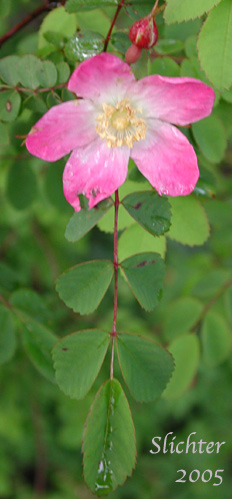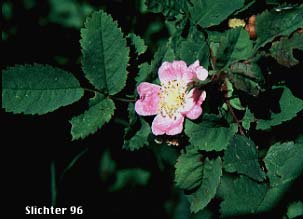
 Characteristics:
Characteristics:
Little wild rose is an attractive shrub with slender, lax stems arising from 30-120 cm in height. The stems are reddish and armed with numerous, straight, soft, fine prickles which are much smaller than those of the other native rose species. The leaves are pinnately compound with 5-9 elliptic to ovate leaflets which are rounded or occasionally pointed tips. The leaflets are thin, dark green above and pale below, and have double-toothed leaf margins, the teeth usually tipped with minute glands.
The flowers are small and usually 1-2 cm across. They are usually solitary at the branch ends. The rose hips are smooth surfaced with pointed tips. They are red or orange, about 6-8 mm long, and do not have the sepals and dried stamens ate the tip of the fruit.
1. Dried flower petals for scents, potpourri.
2. Rose hips are high in vitamin C, may be made into jam, tea, and used as flavoring.
3. Little wild rose may be used as a hedgerow or as an ornamental.
4. The fruits are an important food source by various herbivores and upland game birds. The leaves and twigs are eaten by numerous browsers, and rose thickets provide excellent nesting and escape habitat for songbirds.
The little wild rose may be found in moist to dry woods, or in open upland sites from sea level to nearly 6000 feet in elevation. It is generally not a lowland, wetland plant.
Little wild rose may be found from southern British Columbia south along the western crest of the Cascades to the Sierra Nevada of California. It is found eastward in through Canada to the west slopes of the Rocky Mts in northwest Montana. It is found south along the western edge of Idaho to Boise, and in the Ochoco-Blue Mts and Wallowa Mts. of north-central and northeastern Oregon.
It may be found in the Columbia River Gorge from the western mouth to the gorge to as far east as Seven Mile and the Klickitat River.